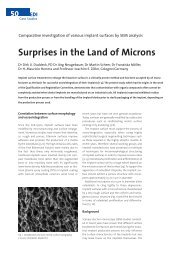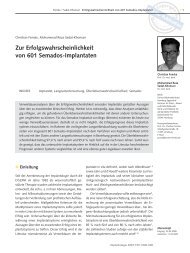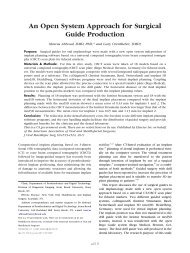implantaten und Aufbau - BEGO
implantaten und Aufbau - BEGO
implantaten und Aufbau - BEGO
Sie wollen auch ein ePaper? Erhöhen Sie die Reichweite Ihrer Titel.
YUMPU macht aus Druck-PDFs automatisch weboptimierte ePaper, die Google liebt.
Originalia – Materials Science<br />
9<br />
Fig. 1 Implant with sealed connection<br />
point<br />
Load resistance<br />
Wool thread<br />
Salt bridge<br />
Superstructure<br />
Implant<br />
Electrolyte<br />
Fig. 3 The half-cells were joined by a salt<br />
bridge to form a galvanic cell. A plastic tube<br />
with a wool thread passing through it served as<br />
the salt bridge. (The tube was constricted in the<br />
middle by a thread loop in order to slow down<br />
the ion exchange. The connecting tube was<br />
filled with the NaCl solution, and when examining<br />
the superstructures in corrosion solution,<br />
the tube was filled half-and-half with NaCl solution<br />
and corrosion solution.)<br />
alloy, in contrast to the other superstructure<br />
materials. Kulmburg (2006) reports that corrosion<br />
currents with the commercially pure titanium/CoCrMoNb<br />
pairing are smaller than with<br />
the commercially pure titanium/high-gold alloy<br />
pairing by a factor of 10 to 100. This is consistent<br />
with the results of our measurements<br />
[4].<br />
The unexpected potential difference and the<br />
flow of current between titanium implant and<br />
titanium superstructure are presumably attributable<br />
to differences in the microstructure of<br />
the metal. The surface of both the superstructure<br />
and the implant were sandblasted and<br />
therefore were no longer homogeneous because<br />
the blasting generates a certain compressive<br />
stress in the metal surface [3]. Mechanical<br />
stresses can, in principle, change the corrosion<br />
behaviour of metals. As a rule, the areas that<br />
have been deformed display increased susceptibility<br />
to corrosion [1]. A further indication of<br />
inhomogeneities is the fact that the titanium<br />
superstructures reacted both more nobly and<br />
less nobly than the implant surfaces in the NaCl<br />
solution at a pH of 6.0. Only at a lower pH, following<br />
the addition of lactic acid, did the titanium<br />
superstructures react consistently less<br />
nobly. The material of the CoCrMo superstructure<br />
is far harder than that of the titanium superstructure.<br />
Measurements with a Vickers<br />
hardness testing device (CV-400DAT, CV-Instruments,<br />
Maastricht, Netherlands) produced<br />
values of 420 +/– 10 HV and 320 +/– 10 HV <strong>und</strong>er<br />
a load of 500 g. It could be that the surface<br />
of the CoCrMo superstructure was changed less<br />
by the sandblasting due to its greater hardness<br />
compared to the softer titanium surface, and<br />
therefore the spread of measurements is smaller<br />
for this alloy.<br />
In terms of the corrosion currents, our investigation<br />
showed the titanium implant/CoCrMo<br />
superstructure pair to be the most favourable<br />
combination. The sandblasted surface of the<br />
CoCrMo alloy reacted more nobly than the titanium<br />
surface, as was the case in Kulmburg’s<br />
investigation using a CoCrMoNb alloy. Only in<br />
the case of the lower pH in the NaCl/lactic acid<br />
solution did the superstructure react less nobly<br />
in one out of four tests. Overall, all the current<br />
densities that we measured were considerably<br />
lower than those reported by Kulmburg (1986)<br />
for the gold alloy/CoCr alloy and gold alloy/NiCr<br />
alloy pairings, for which he obtained values of<br />
100 to 1000 nA/cm 2 [5]. They are also lower<br />
than the values recorded by Taher and Al Jabab<br />
(2003), which were 10 to 30 nA/cm 2 for the titanium/CoCr<br />
cast alloy pairing. This may be attributable<br />
to the fact that we did not use a cast<br />
CoCr alloy, but, according to the manufacturer,<br />
a homogeneous, industrially prefabricated alloy<br />
[6]. There is a good overall match with the<br />
findings of Venugopalan et al. (1998), who reported<br />
currents of 1–3 nA/cm 2 for the titanium/<br />
CoCrMo pairing and 66–154 nA/cm 2 for titanium/high-gold<br />
alloy [7].<br />
It may seem surprising that the cast gold alloy<br />
reacted less nobly than the surface of the titanium<br />
implant. According to Kulmburg (2006), a<br />
more noble reaction would be expected [4]. He<br />
states that commercially pure titanium has a<br />
very base potential, which can be raised by<br />
aro<strong>und</strong> 2400 mV by means of passivation, so<br />
falling just short of the values of precious-metal<br />
alloys. The decisive factor influencing the potential<br />
of the implant surface is thus the development<br />
of the passivation layer. According to<br />
the implant manufacturer, the implant surface<br />
was produced by a special sandblasting process.<br />
Evidently, in the case in hand, the passivated<br />
titanium surface reacts more nobly than<br />
the sandblasted precious-metal surface.<br />
As the sandblasting had the effect of increasing<br />
the surface area of our samples, it may be assu-<br />
Fig. 2 CoCr implant superstructure<br />
with sealed connection point<br />
Fig. 4 Equivalent circuit<br />
diagram for the examined<br />
galvanic cell with implant/<br />
superstructure in the test<br />
set up used. Uo and Ri simulate<br />
the cell; RL is the load<br />
resistance. The voltage at RL<br />
is measured with the external<br />
high-impedance (R>100<br />
GΩ) voltmeter V.<br />
ZWR ̶ Das Deutsche Zahnärzteblatt 2008; 117 (10)


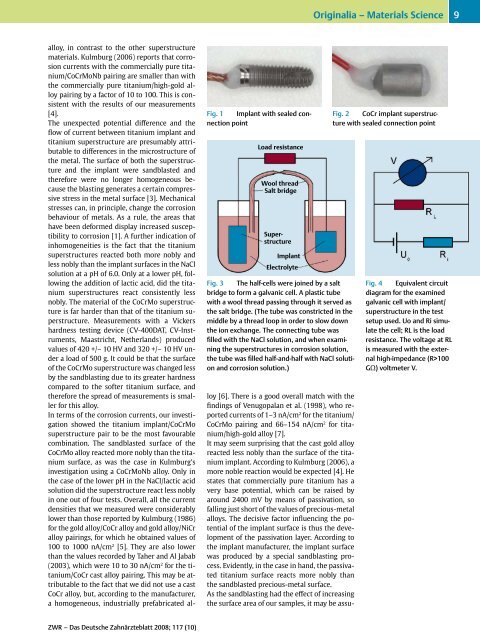
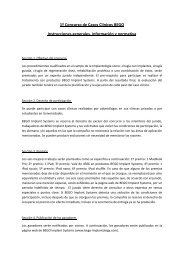
![Folleto del curso [3449823B/pdf] - BEGO](https://img.yumpu.com/49168777/1/184x260/folleto-del-curso-3449823b-pdf-bego.jpg?quality=85)
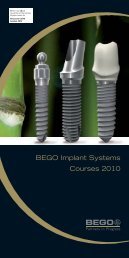
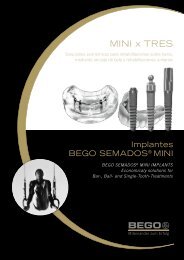
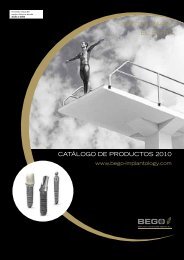
![Folleto del curso [1975602B/pdf] - BEGO](https://img.yumpu.com/35748327/1/190x190/folleto-del-curso-1975602b-pdf-bego.jpg?quality=85)
